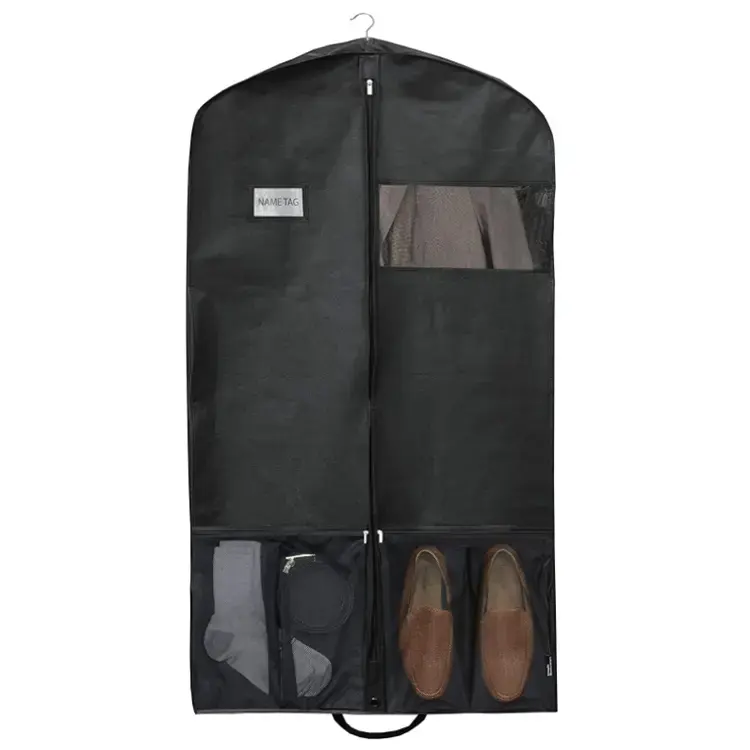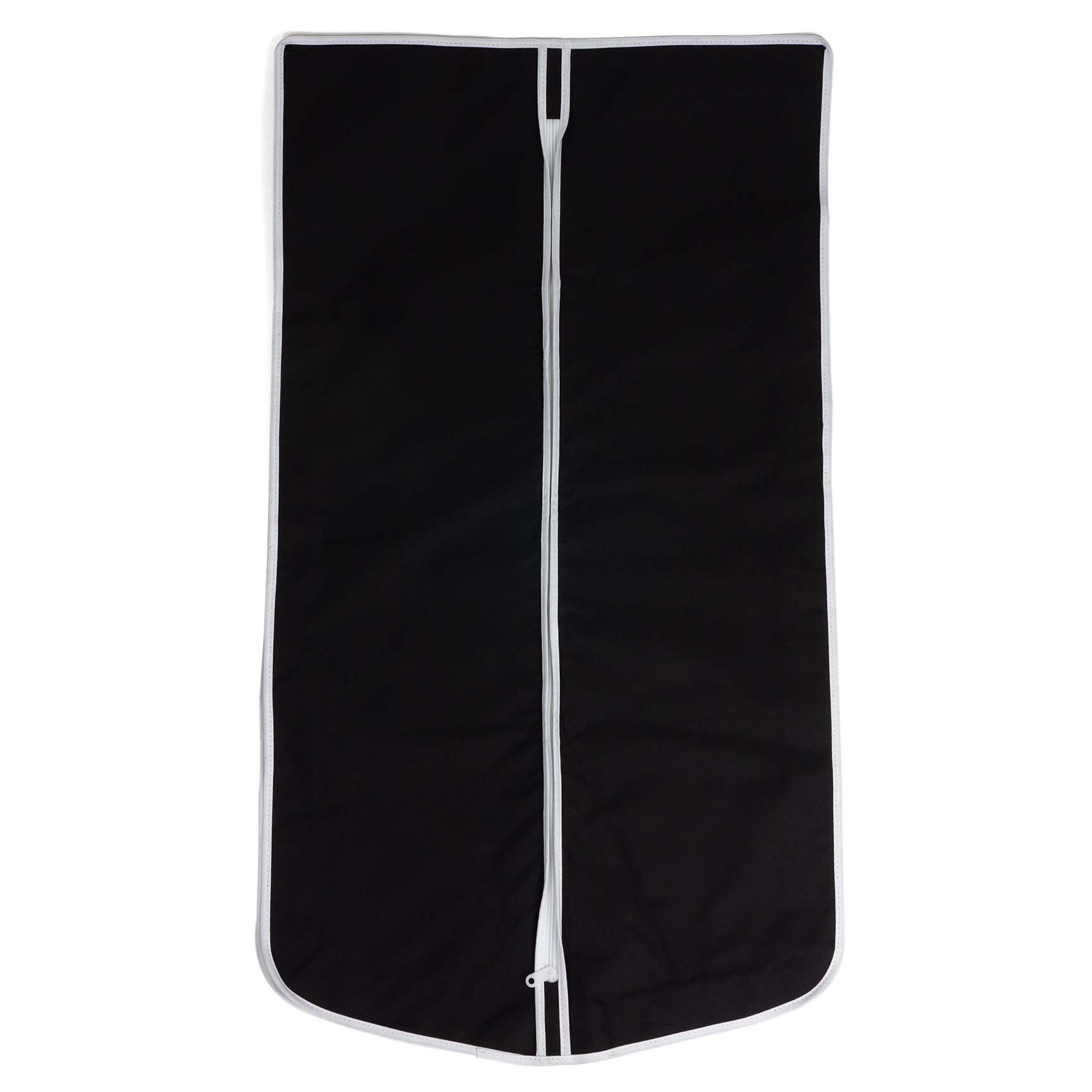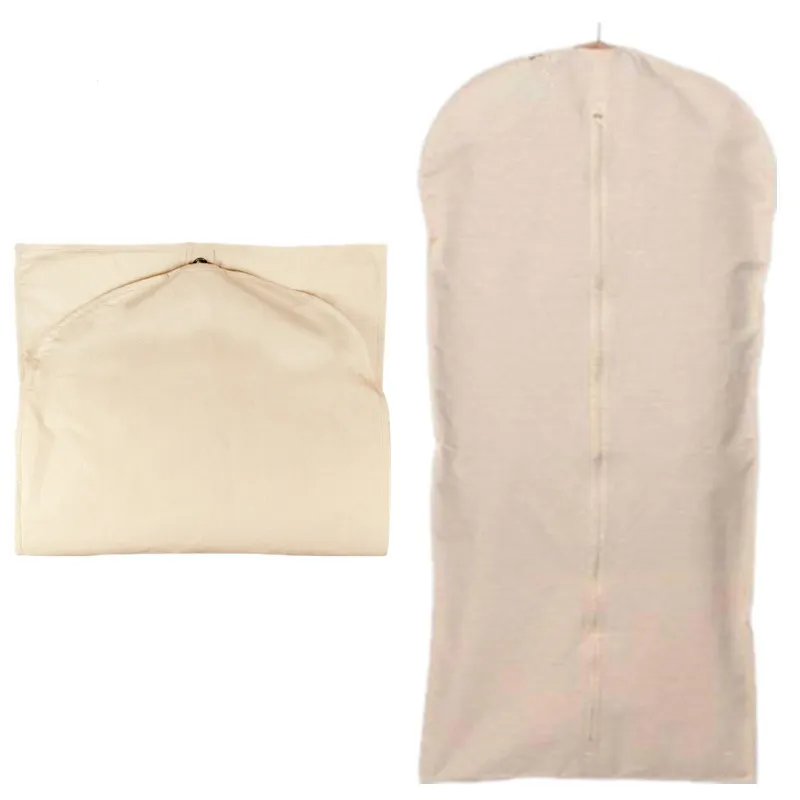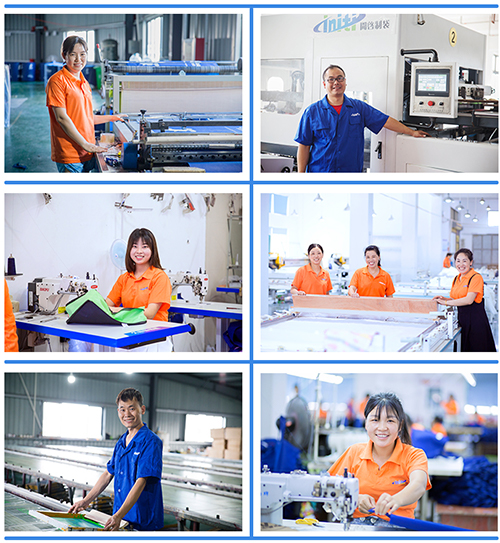How to Source Custom Garment Bags for Wholesale Effectively
Why Are Brands Struggling to Source the Right Custom Garment Bags for Wholesale?
Are you among the many apparel brands, bridal shops, or custom clothing manufacturers that consistently hit roadblocks when sourcing wholesale garment bags? The common pitfalls are frustratingly familiar: bags that are the wrong size, don't match the garment style, fail to showcase your brand effectively, or leave customers feeling underwhelmed. Bridal shops often face challenges finding bags long enough (150cm+) with a gusseted bottom, thick pressure protection, and a transparent window – standard bags simply can't accommodate a wedding dress. Suit brands prioritize sleek, wrinkle-resistant designs, only to receive bags that lack structure or fail to maintain a pressed look. Uniform companies need durable bags with prominent logos, ID cardholders, and hanging loops for on-site distribution, features frequently absent from conventional options.
This pervasive issue can drastically undermine the perceived value of your finished products. A luxury suit or wedding gown paired with a flimsy, cheap-looking bag will likely be discarded immediately, negatively impacting customer experience and brand perception. Brands also miss out on valuable secondary usage (e.g., as travel storage) if bags are unattractive or inconvenient (no handles, non-foldable, too thin). Moreover, when buying in bulk, a lack of brand recognition on the garment bag dilutes your customer delivery image, especially if prints are unclear or craftsmanship is subpar, which severely detracts from your professional image at retail, launch events, or trade shows. This article will equip you with the knowledge to define your needs, select optimal structures and materials, enhance brand presentation, evaluate suppliers, and finally recommend top-tier factories, ensuring you master wholesale custom garment bag procurement.
What is a Garment Bag?
A garment bag is a specialized protective covering designed to transport or store clothing, especially formal wear, suits, dresses, or delicate garments, keeping them wrinkle-free, clean, and dust-free. Typically made from non-woven fabric, polyester, or cotton, these bags often feature a central zipper, a hanger opening at the top, and sometimes handles or shoulder straps for easy carrying, serving as an essential accessory for preserving the condition of clothing durante storage or travel. Garment bags come in various basic forms depending on their primary use: shorter, foldable ones for travel, longer options for storing suits or dresses, and extra-long, often gusseted, versions specifically designed for bridal gowns or elaborate costumes.
Why Using the Right Garment Bag Matters?
Choosing the appropriate garment bag is not merely a practical decision; it's a strategic one that profoundly impacts your brand's perception and overall customer satisfaction.
Elevate Customer Experience & Brand Perception
The right garment bag serves as a critical touchpoint in the customer journey, significantly elevating customer experience and brand perception. When a customer receives their premium suit, delicate dress, or bespoke uniform in a high-quality, thoughtfully designed garment bag, it reinforces the value of their purchase and signals your brand's commitment to excellence. Conversely, a cheap, ill-fitting, or unbranded bag can instantly deflate the perceived value of your product, leaving a lasting negative impression despite the quality of the garment itself. The bag becomes an extension of your brand's identity, conveying professionalism, attention to detail, and care. For custom garment bags with logo, this tangible element reinforces your brand message long after the purchase.
Increase Apparel Value & Reuse Rate
A well-chosen garment bag actively increases the final apparel's perceived value and encourages its reuse rate. For high-value items like luxury suits or wedding dresses, if the accompanying garment bag is flimsy or unattractive, it's often discarded immediately, negating any potential for sustained brand exposure. However, an aesthetically pleasing, durable, and functional bag is likely to be kept and reused by the customer for future travel, storage, or even as a temporary wardrobe solution. This secondary usage essentially turns the bag into a long-term, mobile advertisement for your brand, fostering organic brand advocacy and maintaining a positive brand recall every time it's used.
Wrinkle-Free, Dust-Proof, and Moisture-Proof Storage & Transit Protection
At its core, the primary function of an effective garment bag is to provide wrinkle-free, dust-proof, and moisture-proof storage and transit protection. Garments, especially those made from delicate fabrics or structured designs, are highly susceptible to creasing, dust accumulation, and even minor moisture damage during storage or travel. A properly constructed garment bag allows garments to hang naturally, preventing wrinkles that can occur when clothes are folded or crammed. It forms a protective barrier against external elements, ensuring the clothing remains pristine and ready to wear. This protective capability is indispensable for maintaining the integrity and appearance of your apparel, be it during shipping to the customer or for long-term wardrobe storage.
Scenario Example: The Impact of Low-Quality Bags
Consider this impactful scenario: a high-end bespoke suit or an exquisite bridal gown, representing a significant investment for the customer. If these precious garments are handed over in a flimsy, generic, or poorly constructed bag, the customer's initial impression of your brand can plummet drastically. The disconnect between the garment's quality and the bag's inferiority creates a jarring experience. It signals a lack of attention to detail, potentially undermining the entire brand narrative you’ve meticulously built. In contrast, a robust, custom-designed garment bag reinforces the premium nature of the product, extending the luxury experience beyond the point of sale and fostering deep customer satisfaction.
How to Customize Garment Bags for Wholesale?
Successful customization of wholesale garment bags hinges on a strategic approach, meticulously considering the specific application, material choices, and branding opportunities.
1. Define Specific Garment Bag Needs
The first and most critical step is to define your specific garment bag needs by differentiating between various scenarios such as bridal, uniforms, suits, or performance wear. Each type of garment dictates unique bag requirements and accessories. For wedding gowns, you'll need extra-long bags (often 150cm+) with a gusseted bottom for volume, a thick, anti-pressure material to protect delicate embellishments, and often a transparent window for easy identification without opening the bag. Suit brands typically require bags that are foldable for easy travel, wrinkle-resistant, and may feature structured shoulders to maintain the garment's shape. Uniform companies or workwear factories often need bags with clear ID card pockets, reinforced hanging loops for easy distribution at event sites, and durable materials suitable for repeated use. Considerations like tear-resistant zippers, side handles for convenient carrying, or integrated security features will depend entirely on the primary use case. Clearly specifying these structural details and accessories is paramount for obtaining a functional and effective custom garment bags with logo.
2. Select Materials & Functional Features
Once your structural needs are defined, the next step is to select appropriate materials and functional features that match your brand's quality standards and the garment's requirements. Common materials for wholesale garment bags include non-woven polypropylene (cost-effective, breathable, good for general use), polyester (durable, water-resistant, ideal for travel bags), cotton (premium, natural feel, often chosen for high-end sustainable brands), and RPET (recycled plastic, for eco-conscious brands). Each material offers different aesthetic and protective qualities.
Beyond the base material, consider essential accessory options:
Zippers: Full-length, side, or bottom for easy access. Opt for durable, smooth-gliding zippers.
Handles: Top handles, side handles, or shoulder straps for different carrying methods. Reinforced stitching is crucial here.
Hanger Opening: A small opening at the top for the garment hanger to pass through, often with a reinforced edge.
Clear Windows: For quick visibility of the garment or an ID tag.
Gussets: Expandable sides or bottom to accommodate bulkier garments like wedding dresses, ensuring no crushing.
Breathability: Especially important for long-term storage to prevent moisture buildup and mildew.
Anti-dust/Water Resistance: Treatments or material properties to offer enhanced protection.
The choice of material and features should align seamlessly with your brand's tonality. A luxury brand might choose premium cotton or a thicker non-woven material with subtle, embossed branding, while a uniform supplier might prioritize durable polyester with heavy-duty zippers and clearly visible pockets.
3. Brand Identity & Visual Design
Your garment bag is a potent, often overlooked, marketing tool. Crucial to this is aligning your brand identity and visual design with the bag itself. This involves more than just slapping on a logo; it's about crafting an extension of your brand experience.
Consider LOGO printing methods:
Screen Printing: Most cost-effective for simple designs and large quantities, offering solid color vibrancy.
Heat Transfer Printing: Ideal for complex, multi-color logos, photographic images, or gradients, providing excellent detail.
Embroidery: The most premium option, offering a textured, durable, and sophisticated look, perfect for luxury brands.
Beyond the logo, think about how to enhance brand consistency through design:
Zipper Pulls: Custom-branded zipper pulls add a subtle but impactful touch of elegance.
Bag Color: Choose a bag color that complements your brand's palette, or opt for a classic neutral that allows your logo to stand out.
Font and Typography: Ensure any text on the bag matches your brand's chosen fonts.
Strategic Placement: Consider not only the main logo but also secondary branding elements or subtle patterns that reflect your brand's aesthetic.
Crucially, envision the bag as a mobile billboard and an extension of the customer experience. Every time an individual carries your branded garment bag, it offers passive advertising and strengthens their connection to your brand. A well-designed bag speaks volumes about your attention to detail and commitment to quality, transforming a simple delivery item into a powerful brand ambassador.
How to Work with a Reliable Garment Bag Manufacturer?
Partnering with the right garment bags supplier is paramount to the success of your custom order. A robust communication and verification process is key.
Clear Communication of Details
Begin by providing a clear and comprehensive list of specifications to your potential manufacturer. This should include detailed size diagrams (length, width, gusset depth), precise material requirements (type, thickness/GSM, any specific treatments like water-resistance or breathability), and all printing files in high-resolution vector format (AI, EPS, PDF) for your logo and any other designs. Also, specify the type and quality of zippers, handles, and any specialized pockets or features. The clearer and more detailed your initial communication, the fewer misunderstandings and delays you will encounter during production. Don't assume anything; specify everything.
Sampling and Factory Vetting
Before committing to a bulk order of wholesale garment bags, always request a pre-production sample. This allows you to physically inspect the material quality, verify print accuracy, check all dimensions and features, and assess the overall craftsmanship. This is your last chance to make adjustments before mass production begins. For larger orders, or if you are new to working with a particular garment bags manufacturer, consider conducting a factory audit or inspection. This can be done by a third-party service and helps assess the factory's production capabilities, quality control processes, labor practices, and overall reliability, mitigating potential risks.
Production Timeline and Quality Control
Discuss and confirm the estimated production lead time and Minimum Order Quantity (MOQ) upfront. Lead times can vary significantly based on customization complexity, material availability, and factory workload, so planning ahead, especially for seasonal demands, is crucial. Establish a clear Quality Verification Mechanism. This typically involves receiving production updates, potentially mid-production photo/video checks, and a final inspection of the finished goods before shipment. A reliable garment bags supplier will have robust internal QC processes, but it’s wise to align on your expectations for quality checks. Also, clarify payment terms (deposit, balance), shipping methods (FOB, EXW, CIF), and packaging requirements.
Recommended Garment Bag Manufacturers
Choosing the best garment bags manufacturer depends heavily on your specific needs, volume, budget, and desired level of customization. Here are recommendations from different regions, highlighting their strengths.
1. Initipacking (China)
Initipacking, based in China, stands out as a leading garment bags supplier globally, particularly for businesses seeking deep customization, large production capacity, and competitive pricing. They possess state-of-the-art facilities and a highly integrated supply chain, allowing them to produce a vast array of wholesale garment bags from basic non-woven options to intricate designs for wedding gowns or bespoke suits.
Key Advantages:
Comprehensive Customization: Initipacking excels in tailoring every aspect of the bag. Whether you need an extra-long, gusseted bridal gown bag with a clear window, a foldable suit bag with an integrated carry mechanism, or a uniform bag with specific compartments for IDs and accessories, their engineering and design teams can translate complex requirements into tangible products. They work with a diverse range of materials including durable non-woven fabrics (various GSMs), polyester, cotton, and eco-friendly RPET.
Large Production Capacity & Cost-Effectiveness: Their vast manufacturing scale allows for highly competitive pricing, especially for large-volume orders. This makes them an ideal choice for national retailers, international apparel brands, and promotional companies looking to maximize their budget without compromising on quality for their custom garment bags with logo. They can handle orders from thousands to millions of units efficiently.
Advanced Printing Technologies: Initipacking offers a full suite of printing options including vibrant screen printing for solid logos, intricate heat transfer printing for detailed graphics and multi-color designs, and premium embroidery for a luxurious, tactile finish, ensuring your brand identity is perfectly represented.
One-Stop Service: From initial design consultation and sampling to full-scale production, stringent quality control, and global logistics support, Initipacking provides a comprehensive, hassle-free experience. Their experienced team assists with material selection, feature integration, and efficient delivery.
Global Reach: Located in a major manufacturing hub, they have established logistics channels that facilitate efficient shipping to any part of the world, minimizing transit times and costs.
Best for: Apparel brands, retailers, and distributors looking for a highly versatile, cost-effective, and large-scale manufacturing partner capable of complex customization for their wholesale garment bags needs.
2. Promier Products (USA)
Promier Products is a US-based garment bags supplier primarily known for its efficiency in serving the North American market. They specialize in promotional products, offering quick lead times for standard wholesale garment bags that can be customized with a logo.
Key Advantages:
Speedy Turnaround: Ideal for urgent orders within the US, reducing shipping times dramatically.
Local Support: Direct communication, easier for resolving issues within the same time zone.
Familiarity with US Market Needs: Often stock popular bag styles suitable for common promotional uses.
Limitations:
Higher Unit Price: Generally more expensive than overseas counterparts due to higher labor and operational costs.
Limited Deep Customization: Their strength is often in adding logos to existing bag designs rather than fully bespoke manufacturing from scratch.
Smaller Production Scale: May struggle with extremely large orders or highly complex design requirements.
Best for: US-based businesses that prioritize speed, ease of communication, and need standard garment bags with quick turnaround for promotional events or smaller custom runs.
3. Hangerworld (UK)
Hangerworld is a prominent UK-based company specializing in storage and organization solutions, including a broad range of garment bags. While they serve both retail and wholesale customers, their focus is often on high-quality home and commercial storage products.
Key Advantages:
Quality & Durability: Known for producing robust and durable garment bags suitable for long-term storage and everyday use.
European Market Focus: Efficient distribution within the UK and Europe, offering localized customer service.
Diverse Product Line: Beyond basic garment bags, they offer specialized covers for various garment types and other storage solutions.
Limitations:
Higher Cost for Bulk Customization: While they offer customization, their pricing for large-scale, intricate custom orders can be significantly higher than Asian manufacturers.
Lead Times for Complex Customization: May not be as agile as dedicated garment bags manufacturer for highly unique, large-volume production runs.
Mainly Stock Options: While customization is available, a larger portion of their business might be built around ready-to-ship standard products.
Best for: UK and European businesses, retailers, and hotels seeking quality, ready-stock garment bags, or custom solutions for mid-sized orders, prioritizing local supply and established quality.
Conclusion
In the competitive apparel market, the right garment bag transcends mere packaging; it serves as vital protection, a powerful brand ambassador, and a key enhances of the customer experience. Choosing the ideal garment bags supplier is therefore not an expense, but an investment that significantly magnifies your brand's value. Don't let packaging be the weakest part of your premium garments.
Ready to elevate your brand protection and presentation? Reach out today to receive custom samples, get a fast quote, and collaborate on a design solution tailored specifically for your brand.
Hot Tags:Shopping Bag,corduroy bag,China, suppliers, manufacturers, factory, wholesale, in bulk, for sale,tote bag ideas,canvas bags for storage,cotton shoulder bag, rpet bag, custom garment bags,canvas drawstring bags,Insulated lunch cooler bag,makeup cosmetic bag for sale,Grocery and Shopping tote bag,Beach Accessories,Jute/hemp/burlap tote bag,Corduroy tote bag,Travel bag,Linen bag,Paper bag





